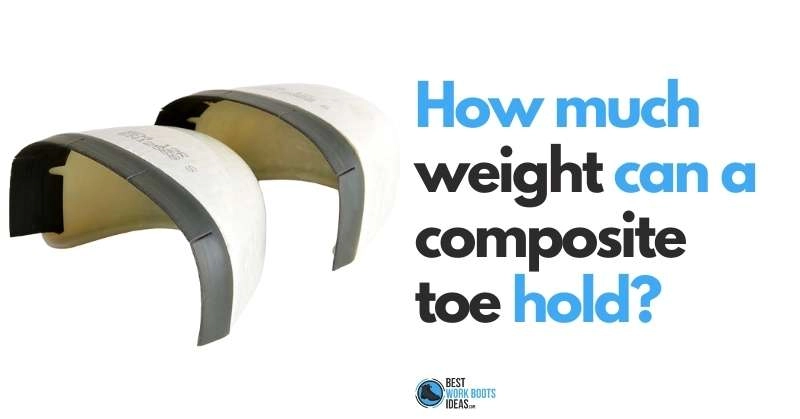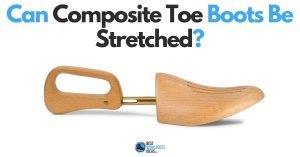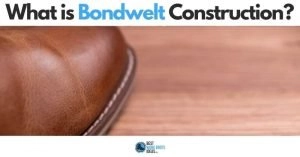Your Complete Guide to Everything There is to Know About How Much Weight Composite Toe Work Boots Can Hold

One of the biggest questions in the PPE and work boot worlds concerns composite toe caps.
Is this modern technology the answer to the issues associated with steel toe caps, or just marketing bluster.
In this article I work to clarify some of the misconceptions about composite toes, particularly regarding their weight capacity. Let’s get into it!
Contents
How Much Weight Can a Composite Toe Hold?
As an average, composite toe safety boots can withstand an impact from a 50 pound object falling from 18 inches above. They can also handle compression of 2,500 pounds of force while still leaving your toes a half inch of breathing room to escape after an accident.
If you read anything claiming greater weights than this on the internet and the article doesn’t have a citation, don’t trust it!
I’m not saying it’s not possible, I’m just saying possible and provable are different things.
During the writing of this article, I was shocked at how many websites and articles threw incorrect information up without any way to prove it.
If you’ve found someone promising things that seem too good to be true, be wary.
What’s A Composite Toe?
A composite toe is a toe cap made entirely of non metallic materials.
No steel, aluminum, or other alloys can claim that they are composite.
The term could just as easily be “non-metallic,” and mean the same thing.
Reaching Out to Manufacturers For Further Information
Prior to writing this article I wrote to a couple manufacturers with some composite toe questions.
I was hoping that I would get a specific answer about weight capacity in their composite products.
It was hoped that I’d have more detailed information than ASTM standards for you.
To my great regret, one company gave a stock answer about how they care about their customers safety and all composite toe caps pass ASTM tests (I should hope so).
The other didn’t bother to answer at all.
I was a blue collar worker, a business owner in the trades, and I sympathize with anyone reading this thinking, “okay, so what does this tell me?”
I had been hoping that before this got published I’d have a couple answers for you, but it’s not looking to be the case.
However, I will try my best to provide as value as I can for you.
Are Composite Toe Boots OSHA Approved?
If a pair of composite toe boots pass the necessary ASTM tests and adhere to OSHA guidelines then yes.
Keep in mind: your workplace might have specific Personal Protection Equipment (PPE) requirements that exceed OSHA’s baseline requirements.
Always make sure to check with your foreman, boss or HR to be sure.
Are All Composite Toes Made With the Same Materials?
No, composite toes can be made from a number of different materials.
Some are made from TPU, the same material that covers electrical cables.
Others are advanced materials that had prior been used in only industrial and military applications.
TPU is an amazing material, will keep your toes safe, but is the least advanced of all the composite materials.
It’s a hardened plastic that will do the job, but takes up a lot of space while doing it.
This makes for a boot that seems to bulge out from the toe.
Fiberglass makes up a good number of composite toe boots and for good reason.
It’s extremely durable, breathable, and 50% lighter than steel.
It’s also extremely thin, so this makes boots with fiberglass composite toes very comfortable to wear.
Carbon Fiber and Kevlar toe caps are considered to be the gold standard amongst the composite toe options.
They are both extremely light, extremely strong, and don’t take up much physical space.
Keep in mind, you’ll pay a premium for boots with these types of toe caps.
Are Steel Toes Stronger Than Composite Toes?
Referring to non-scientific tests done by regular workers, steel toes are stronger than TPU and fiberglass toe caps.
I cannot speak for direct comparisons of steel against both carbon fiber and kevlar, as there’s no data available to conclusively prove this.
Relying on abstract material information isn’t sufficient with safety gear, actual tests need to be done on actual toe caps.
Manufacturers are concerned with passing the ASTM test that ensures they’ll be OSHA approved; understandable.
Unfortunately, they fail to give exact numbers of compression limits based on each toe type.
This is something I hope changes in the coming months and years.
If you want to know how much a steel toe boot should weigh then we have a complete article on this too.
Are Composite Toe Boots More Comfortable Than Steel Toe?.
The material that makes up a composite toe cap plays a big part in whether the boot is comfortable.
More advanced materials like carbon fiber and kevlar are more comfortable than steel toe boots.
TPU composite toe caps aren’t inherently more comfortable, just different so shouldn’t affect the fit too much.
What Are the Benefits of Composite Toes?
Composite toes are lightweight, resistant to a number of environmental conditions, and do not conduct electricity.
They provide their wearers a number of benefits regarding fatigue-prevention and mobility.
What Kind of Workers Look for Composite Toes?
People who work in situations where electrical contact is a high likelihood tend to prefer composite toe work boots.
Also, anyone who is required to move around a lot during the course of their work day likes lighter boots, lighter boots create less fatigue.
Composite toes are 30% lighter than steel toe boots on average.
This may seem like a small difference, but even a small difference adds up when multiplied by tens of thousands of steps each day.
People who are looking for a more balanced work boot also tend to look for composite boots.
This isn’t a joke, there is scholarly research that shows an increase in lower leg and knee injuries as a result from heavy footwear.
While a little different from the argument behind zero drop footwear, the suggested cause of these injuries are the same: boot design that restricts or changes the natural gait and movement of the human body.
While certainly not light as sneakers or no shoes at all, composite toe boots help lower the amount of stress on your body compared to steel and alloy toe boots.
That’s All For Now!
This is one of those articles I regret I don’t have more to say, but I’d rather be totally transparent with you.


![Are Steel Toe Boots Safe [featured image]](https://www.bestworkbootsideas.com/wp-content/uploads/2022/03/are-steel-toe-boots-safe-featured-image-300x157.jpg)
![Carbon Toe vs Composite Toe [featured image]](https://www.bestworkbootsideas.com/wp-content/uploads/2022/05/carbon-toe-vs-composite-toe-featured-image-300x157.jpg)

